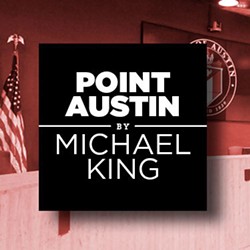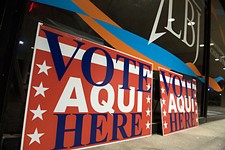Point Austin: Hiding in Plain Sight
Here's your lecture on voting: Vote.
By Michael King, Fri., April 29, 2011

– Mayor Lee Leffingwell
With characteristic wryness, Mayor Leffingwell described at least one of the motivations for the package of City Charter reforms under consideration by City Council today (Thursday, April 28). The renewed push for geographic (single-member) districts and a fall election date, along with several other proposals, would presumably provide greater motivation for Austinites to confirm our supposed reputation for public engagement by actually turning out to vote in city elections. The evidence is hardly in our favor. As Austin Community College professor Stefan D. Haag reports in his 2009 study of local voter turnout, "The number of voters in Austin mayoral elections has remained fairly constant since 1971. However, the number of registered voters in Austin increased from 93,597 to 450,715 between 1971 and 2009. Consequently, the voter turnout rate, measured as the percentage of registered voters who cast ballots, declined from 56.8 percent in 1971 to 13.1 percent in 2009."
That's right, a whopping 13.1% of our engaged (and registered) citizenry turned out to elect the mayor and four of the current council members. (Nonmayoral races generally do worse by half.) Note as well the obvious anomaly in those numbers – about the same total number of voters have been voting since 1971, but the number of registered voters has grown nearly fivefold. Why so many folks take the trouble to register but then fail to vote remains a puzzle to me, but it does raise the curious possibility that mostly the same people have been voting around here for the last 40 years. If we all pass away about the same time, will the voting percentage move inexorably toward zero?
Haag's study points out that Austin's decline is not unique: "Since 1979," he writes, "voter turnout rates in major cities throughout the United States have declined by more than 20 percent. ... The decline in voter turnout in Austin is comparable." So whatever the causes, it's apparently not the fluoride in Austin's water. Across the nation, older folks tend to vote at much greater rates than youngsters, and national elections (given more sensational headlines and saturation coverage on TV) draw many more voters than local elections. The latter is also one reason the charter proposals would move the city elections – of all council members, for four-year terms – to coincide with presidential Novembers. Presumably many more people would vote, and it would also save money by simply reducing the total number of elections.
Passions on the Simmer
In this context, such musings normally trigger a columnist's rote obligation to lecture his readers on the sacred obligation to take part in the hallowed tradition of voting, etc., etc., etc. While I do think folks should take the time to review the council candidates and vote (see our endorsements and Wells Dunbar's coverage), as deliverer or receiver I've never found moral lectures terribly persuasive, and I suppose my neighbors can provide a thousand apparently good reasons why they couldn't make it to the polls over the next two weeks of early voting (May 2-10) or on Saturday, May 14.
Last night I read an interview with political consultant David Butts, who cited the standard explanations for turnout decline and also offered this: "After the '92 SOS election and then the '97 election of Kirk Watson and the 'green council,'" he said, "voters have more or less concluded that the direction they wanted the city to go in has been achieved. Conflicts have gone from a raging fire to a simmer. It has become more of a battle between the different factions within the progressive community, so it's a little harder for voters to discern who's who in the races." ("On the Record With Diane Holloway," on the Travis County Democratic Party blog.)
Of course, campaign partisans have a stake in turning simmers back into raging fires, a process currently under way in the Place 3 council race between incumbent Randi Shade and challenger Kathie Tovo – where the substantive policy differences are frankly unremarkable. Butts is currently helping Tovo, and as a campaign matter, ironically, she's likely to be much better off with a low turnout – in a potential run-off with Shade, the even tinier electorate will expand the importance of the most central city boxes, where Tovo's support is presumably stronger or at least more persistent.
Double or Nothing
Although the engaged political consensus has been for years that single-member districts are definitely the way to go (the standard proposals are for a mixed geographic and at-large system), the voting public has yawned at the planning and repeatedly rejected the idea at the polls. I asked Leffingwell if he thought this effort – whether it happens next year, as he thinks best, or this fall, as has been suggested by more impatient proponents – would have any better chances of success. (There is also state legislation pending that could impose the change.) "I think the difference this time," he said, "is that people in the northwest and southwest are also complaining that they are not represented on council – which is true; all the current members are from the central city. And if that feeling joins with the traditional supporters [generally minority/Eastside voters also feeling underrepresented], it might make for an unusual alliance, but an effective one."
We'll see. If a threatened ChangeAustin.org petition drive this summer forces the issue for November, a proposition for 14 or more districts might land on the ballot against a council proposition for a "6-2-1" system (six districts, two at-large, and the mayor). While that might not give voters much time to consider the eventual details, it might also give the ever-recurring idea a chance to squeak through this time, as a pick-one proposition. At least we'd finally get to see if single-member voters are any more interested than the current variety.
Catch the public yawn at www.twitter.com/PointAustin. The Stefan D. Haag study on voter turnout for the ACC Center for Public Policy and Political Studies is posted here: Voter Turnout Study. For a snapshot of voter-turnout highs and lows over the last 90 years, see "Spring Council Elections."
Got something to say on the subject? Send a letter to the editor.










